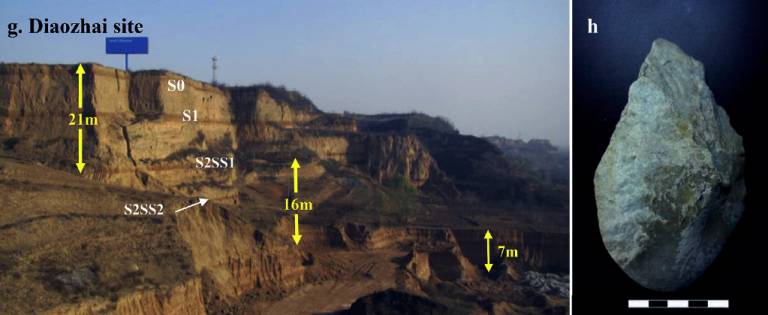Lower Palaeolithic stone tools have been found in Lantian County, China
20 April 2017
The Homo erectus cranium, mandible and hundreds of associated lithic artifacts found in Lantian (central China) in the 1960s demonstrate that the area was important for hominin habitation during the early to middle Pleistocene.
 However, the region, which was not adequately researched until the early 2000s, still poses several questions regarding hominin behavior and lithic technology development. In this study, three loess-paleosol sequences (the Jijiawan, Ganyu and Diaozhai sites), from which in situ stone artifacts were recovered, are investigated and dated by optically stimulated luminescence (OSL), magnetostratigraphy and stratigraphic correlation. The results demonstrate that the artifacts are located within paleosol layers S4 (correlative with marine oxygen isotope stage (MIS) 11), S3 (MIS 9), S2 (MIS 7), and S1 (MIS 5); and within loess layer L1 (MIS 2-4). The main stone-knapping technique used was direct hard hammer percussion. In addition, the technological features of the stone tools found at these sites exhibit little variation, indicating the presence of a long-established, stable technology in the Lantian area. These observations show that the ancient humans lived episodically on the terraces of the Bahe River from the early Pleistocene, indicating a long history of hominin occupation of the region.
However, the region, which was not adequately researched until the early 2000s, still poses several questions regarding hominin behavior and lithic technology development. In this study, three loess-paleosol sequences (the Jijiawan, Ganyu and Diaozhai sites), from which in situ stone artifacts were recovered, are investigated and dated by optically stimulated luminescence (OSL), magnetostratigraphy and stratigraphic correlation. The results demonstrate that the artifacts are located within paleosol layers S4 (correlative with marine oxygen isotope stage (MIS) 11), S3 (MIS 9), S2 (MIS 7), and S1 (MIS 5); and within loess layer L1 (MIS 2-4). The main stone-knapping technique used was direct hard hammer percussion. In addition, the technological features of the stone tools found at these sites exhibit little variation, indicating the presence of a long-established, stable technology in the Lantian area. These observations show that the ancient humans lived episodically on the terraces of the Bahe River from the early Pleistocene, indicating a long history of hominin occupation of the region.
Chronology of newly-discovered Paleolithic artifact assemblages in Lantian (Shaanxi province), central China
Haixin Zhuo, Huayu Lu, Shejiang Wang, Khobaib Ahmad, Wenfeng Sun, Hongyan Zhang, Shuangwen Yi, Yongxiang Li, Xianyan Wang
DOI: 10.1016/j.yqres.2016.08.008
 Close
Close

